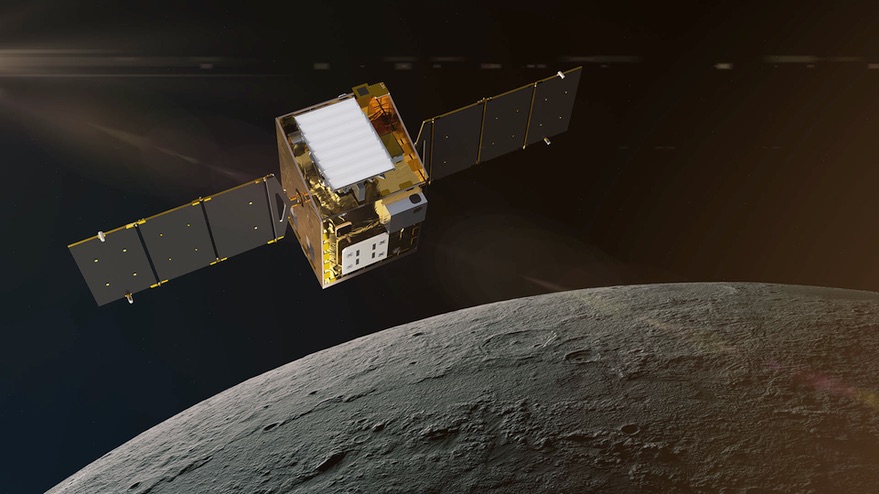Products You May Like
WASHINGTON — NASA is looking at options to move up the launch of a small lunar orbiter mission, illustrating the challenges the agency faces as it seeks to make greater use of rideshare launch opportunities.
The Lunar Trailblazer spacecraft is an orbiter equipped with a spectrometer and thermal mapper to study the distribution of water on the moon. The mission passed its Key Decision Point (KDP) C review in November, clearing it for full-scale development.
The spacecraft is scheduled to be completed in October 2022. However, it will not launch until at least February 2025, since it is flying as a rideshare payload on the Falcon 9 launch of the Interstellar Mapping and Acceleration Probe (IMAP). That mission’s launch was postponed last year from October 2024 to February 2025 because delays in its development caused by the pandemic, postponing several rideshare payloads like Lunar Trailblazer flying with it.
That delay came up during a discussion of NASA planetary science projects at the March 24 meeting of the Committee on Astrobiology and Planetary Science of the National Academies. Clive Neal, a committee member from the University of Notre Dame, asked if it would be possible to launch Lunar Trailblazer as a co-manifested payload on one of the series of Commercial Lunar Payload Service (CLPS) missions that will be launching to the moon starting late this year.
“We’re looking across the whole directorate, looking for another ride for Lunar Trailblazer; a little sooner, if that’s possible,” responded Lori Glaze, NASA planetary science division director. She said NASA was not taking Lunar Trailblazer off the IMAP launch just yet, “but we are looking and we’re keeping our eyes open” for other opportunities.
NASA has issued awards for six CLPS missions to date, including two each to Astrobotic and Intuitive Machines and individual missions to Firefly Aerospace and Masten Space Systems. Each mission will deliver a set of NASA payloads to the surface of the moon on landers developed by those companies, which may also contain payloads from other customers.
It’s unclear if any of those missions have enough excess capacity to include the Lunar Trailblazer orbiter, in part because some of them have not yet announced their launch plans. However, Glaze noted the nature of the CLPS program, where NASA buys payload services rather than the landers themselves, would make it more difficult to add a co-manifested payload. “We’re buying a service from them, and the service we’ve contracted with them is for the instrument payloads,” she said.
NASA has been increasing the use of rideshare launch services for some of its smaller missions, taking advantage of the excess capacity on launches of larger spacecraft. Lunar Trailblazer is just one of four secondary payloads on the IMAP mission, joined by NASA’s Global Lyman-alpha Imagers of the Dynamic Exosphere (GLIDE) and Solar Cruiser heliophysics missions and NOAA’s Space Weather Follow-On L1 mission.
Lunar Trailblazer is part of NASA’s Small Innovative Missions for Planetary Exploration (SIMPLEx) program, which in 2019 selected Lunar Trailblazer and two other mission concepts for development. Each mission is no larger than 180 kilograms, to take advantage of rideshare launch opportunities, and has a cost cap of $55 million.
Lunar Trailblazer is not the first SIMPLEx mission to run into rideshare launch issues. In September, NASA said that the Escape and Plasma Acceleration and Dynamics Explorers, or EscaPADE, mission to Mars would not fly as originally planned as a secondary payload on the launch of the Psyche asteroid mission. A change in launch vehicle for Psyche, from Falcon 9 to Falcon Heavy, changed the trajectory for Psyche to one that was no longer viable for including EscaPADE.
NASA has not yet found an alternate ride for EscaPADE. Glaze said at the committee meeting that, because of that, the agency has delayed the KDP-C review for EscaPADE to “sometime this summer.”
The third SIMPLEx mission, Janus, will launch with Psyche to fly past binary asteroids. “Janus is progressing very well,” Glaze said, having passed its KDP-C review in September 2020 and its critical design review in February.
That group of three SIMPLEx missions follows an initial round that supported cubesat-class missions. One, the CubeSat Particle Aggregation and Collision Experiment, or Q-PACE, is a 3U cubesat designed to study planetary accretion processes by observing low-speed collisions of particles in microgravity.
Q-PACE launched Jan. 17 as part of the Launch Demo 2 mission by Virgin Orbit’s LauncherOne. However, Glaze said that, since launch, controllers have yet to make contract with Q-PACE. “There’s dwindling hopes on Q-PACE,” she said.
The other SIMPLEx cubesat is LunaH-Map, a 6U cubesat that will look for lunar ice at the south pole of the moon. It is one of 13 secondary payloads on the Artemis 1 inaugural launch of the Space Launch System no earlier than late this year. Glaze said that mission remains on track to be flown on Artemis 1.
NASA has not issued a call for proposals for a third round of SIMPLEx missions. “The primary reason for that is that we just don’t have the budget in order to offer it right now,” she said. That includes maintaining flexibility to address COVID-related budget impacts to other planetary science programs at the agency.
“That’s no way a sign that I’m not interested in SIMPLEx,” she added, praising the progress by Janus and Lunar Trailblazer. “It’s a fantastic way to do science at a smaller cost point. I am really looking forward to being able to say we can offer SIMPLEx 3, but until we have a solid budget that can support it, we’re just not able to offer it at this time.”
